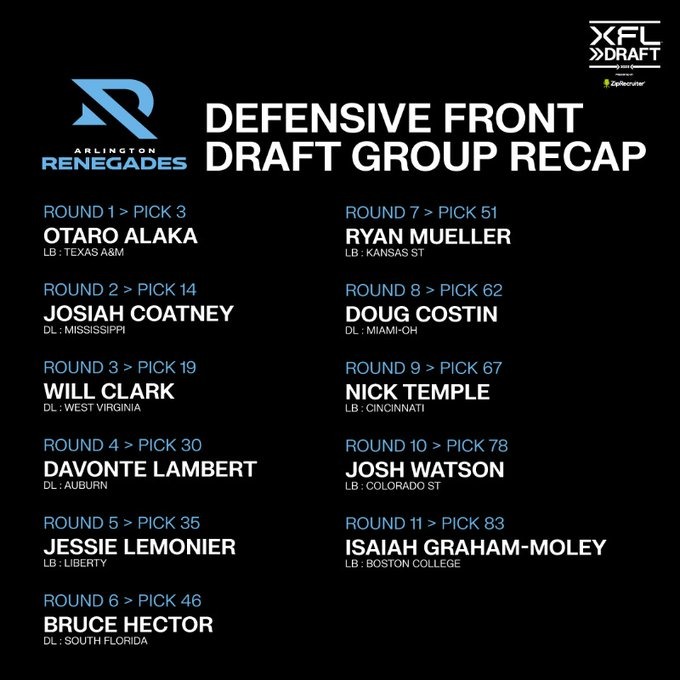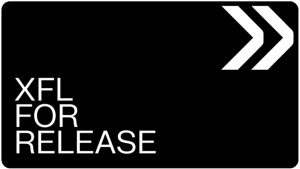In preparation for the upcoming XFL Rookie Draft, I’m reflecting back on the first draft, held last November, where teams began to build their rosters. This is part three, looking at the Defensive Front Seven Phase. Part one, analyzing the Skill Position Phase, can be found here, while part two, the Offensive Line Phase, is available here.
Draft analysis and rankings are ultimately subjective, but to add a little but more objectivity to the exercise, I decided to rank each team by the number of snaps played by draftees of that team in that particular phase. Obviously not all snaps are created equal, but I do think this pretty accurately reflects how well each team did.
1. Vegas Vipers (3,336 snaps)
This was the high-water mark for snaps any team got out of any phase of the draft. Vegas was the only team to cross the 3,000 snap threshold in a phase, and it wasn’t really close. Only Roderick Henderson did not make the team, and having been selected in the 10th round, that’s a “miss” Vegas can live with. Six of the remaining 10 picks played all 10 games for Vegas, including both their first and second round choices. Of the Vipers’ 20 sacks on the season, 15.5 came from players drafted in this phase. Even though Vegas finished 2-8 and the team ended the season at the bottom of most defensive metrics, at least they can say they got value out of the Defensive Front Seven Phase of the draft.
2. Orlando Guardians (2,663 snaps)
Surprised? So was I. This is where the “quality vs. quantity” debate diverges. Orlando ended up with a quantity of production from their Front Seven draft, but it didn’t necessarily equate to quality production. DeCalon Brooks, the son of former NFL LB Derrick Brooks, was the only player drafted in this Phase not to take a snap for the Guardians this year, as he ended up on the injured reserve list in early February. All others contributed in some way. In fact, the top three leading tacklers for Orlando at the end of the season were all taken in the Defensive Front Seven Phase. Of the six linebackers and defensive linemen that make up starting spots on the team’s depth chart by the end of the year, five were drafted here.
3. Seattle Sea Dragons (2,623 snaps)
A mere 40 snaps separates second and third place in this phase. Seattle had to wait out Niko Lalos’s practice squad contract with the New Orleans Saints for him to come to camp. After the XFL season, Lalos re-signed with the Saints. Third rounder Curtis Weaver signed a futures deal with the Minnesota Vikings in January, making him unavailable to the Sea Dragons. Seattle managed to get most of its starters and a fair amount of depth from this phase of the draft. First rounder Elijah Ponder ended up as a starting OLB in the 3-4 alignment the Sea Dragons used. They found great value in the 10th round where Tuzar Skipper was selected. Skipper led the team in sacks and tackles for loss. Had it not been trips to injured reserve for several of these players (Emmanuel Smith, PJ Hall, Jordan Evans), they would’ve leap-frogged the Guardians for second place.
4. DC Defenders (2,266 snaps)
The Defenders finished fourth despite some holes in this Phase. First round pick Niles Scott was placed on injured reserve during training camp and was lost for the season. Eighth rounder Joe Wallace replaced Scott’s sizable bulk in the starting lineup. Anthony Hines was the leading tackler for the Defenders from this group, and he was only sixth on the team in stops. Many of the front seven impact players came from the Supplemental Draft, where DC loaded up with guys like Francis Bernard, Davin Bellamy, and Reggie Northrup. Players such as Hines, Andre Mintze, and Jamal Brooks were important depth pieces who, as indicated by DC finishing fourth here, still played a fair amount of defensive snaps.
5. St. Louis Battlehawks (2,240 snaps)
First round pick Lakiem Williams didn’t have a lot of influence on defense. He started just two games, though St. Louis rotated their linebackers often. Second round pick Emeke Egbule was with the Pittsburgh Steelers throughout the XFL season; he was recently released and St. Louis would presumably hold his rights if he were to join the XFL next year. That would be a nice addition for the Battlehawks. Lacale London, a fourth rounder, ended up playing the most snaps of anyone drafted in this phase for the team. Aside from Drew Singleton, everyone chosen in rounds three through nine made contributions. Neither of the final two draftees made the squad out of training camp.
6. Houston Roughnecks (1,645 snaps)
The snaps drop off steeply from fifth-place St. Louis to the remaining three teams. The gem in this phase was third round LB Tavante Beckett. He started nine out of 10 games, led the Roughnecks in tackles, and paced this group in playing time. The first two picks were major pieces on defense, with John Daka contributing to Houston’s strong pass rush. After that, however, it was a real crapshoot: Austin Edwards and Ellis Brooks both spent the season on IR. Tariqious Tisdale ended up playing late in the season for Seattle. CJ Brewer and Chauncey Rivers were the only players in the back-half of the phase to make the team. Fourth rounder Elijah Qualls did not report.
7. Arlington Renegades (1,324 snaps)
Third overall pick Otaro Alaka was lost for the season 17 snaps into the first game of the year. He was poised to play a major role on defense for Arlington. Second rounder Josiah Coatney played eight games as a reserve. The Renegades got significant snaps out of 31-year old Will Clarke, their third round pick, who played and started nine regular season contests. Ryan Mueller was on-and-off the roster during the regular season. Nick Temple was set to make the team but three days before the first game was released when Arlington picked up Darnell Sankey from the CFL. Isaiah Graham-Mobley turned out to be a nice pick in the final round. The mid-round defensive linemen played but had little impact.
8. San Antonio Brahmas (792 snaps)
While Vegas notched the most snaps of any team in any phase with the Front Seven, San Antonio had the fewest snaps from the Front Seven of any non-Open phase. What went wrong? Two players, Prince Emili and Owen Carney, were signed to NFL practice squads in the fall and then futures contracts in January, preventing them from playing for the Brahmas. First round pick Justin Alexandre was placed on the Non-Football Injury List in February and didn’t play all season. Second rounder Riko Jeffers missed three games to injury. Most others either declined the invitation to play in the XFL or were cut before the season. The two players who played the most snaps from this phase were the last two picks: Drew Beesley and Mike Tverdov. It’s impressive that San Antonio’s defense was so good considering this phase was a huge swing and a miss.






















